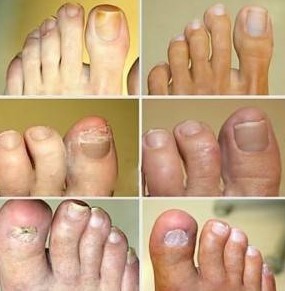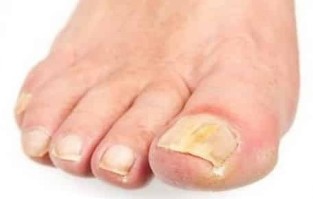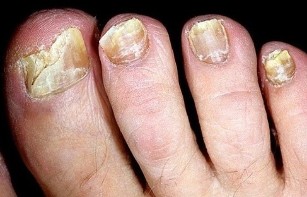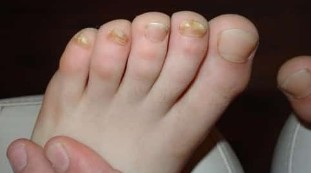Onychomycosis – a malocclusion, which destroys the nail plate. The fungus eats the keratin – construction of the base of the nail. The infection enters in the intercellular space and begins its division. In the execution of the initial stages malocclusion can affect the skin of the feet, interdigital area of the heel.

Causes of toe nail fungus
Contracting onychomycosis quite easily. The infection can lie on the beach, public, shower, swimming pool. High chances of contracting the fungus-infected relatives or acquaintances (the use of generic tools for the home).
There are some important assumptions, which are able to cause the penetration of the virus in the human body:
- a weak immune system – reducing defenses transferred due to an infectious or inflammatory in nature;
- malocclusion vascular (obstruction of veins) breach of the functioning of the internal organs (diabetes mellitus), which can lead to problems with the circulation of blood in the lower limbs;
- minor damage of the skin of the sole of the foot (abrasions, cracks, corns, calluses), arising from the wearing of a tight shoe;
- ignoring the diaper rash and intense sweating of the lower limbs;
- violation of the measures of caution – try shoes of someone else, to visit public places without slippers, and neglecting the hygiene of the foot.
The types of nail fungus
Onychomycosis can cause different types of mushrooms. Dermatophytes, for example, manifest themselves in the form of opacity of the nail. We observe the formation of yellow spots on the edges or in the middle of a plate. Also, can occur as longitudinal stripes along the affected area.
The yeast fungus causes a deformation of the nail plate. She is a very diluted and begins to move away from his place, becomes grayish. The metabolism of the injured cells is reduced, the nail cushion appear to be furrows. In addition, the adjacent skin appears inflammation, swelling, redness, it is observed the disappearance of the nail of the skin.
Mold bacteria can damage the nail plate, if you already have diseases that cause eating disorders in the nails. In this case, also occurs in the penumbra plate, changing its colour (from light yellow and green to brown and even black).
To find out the cause and pathogen-negative changes in the skin and nails, it is necessary to consult a specialist. Self-definition of the disease and its treatment without the advice of the doctor can be fraught with consequences.
The initial phase of the disease

Athlete's foot nail affects the healthy cells little by little. The disease has several stages of development, each characterized by the specific manifestations.
The first phase of the onychomycosis (normotroficheskie) has no vivid manifestations. In the majority of cases, it runs hidden. The first signs – the nail a little fogging, is changing its color, form cracks and yellow stains in the shape of a circle or predilecta, appears tuberosities. A beginner's mushroom can be accompanied by itching and burning. To correctly recognize the infection in the initial stage difficult, because the symptoms are similar with other diseases (psoriasis, malocclusion of the liver).
If time does not begin treatment, the disease enters the next phase – hypertrophic. The nail becomes thickened, dark. Occurs the deformation of the plate, his the and destruction.
Launched form of nail disease manifests as a strong thinning of the nail plate, which leads to further loss of hair. Adjacent to the skin becomes blue, there is an unpleasant smell.
The symptoms
Onychomycosis most often affects the nails of the feet, less likely to suffer from hand. The disease begins with the thumb and the little finger (interested in the outer edge), without solution of continuity that hits all the dishes.
To determine the fungal infection is help the main symptoms of onychomycosis:
- the appearance of streaks and spots, whitish or green hue under the nails;
- opacity the plate, changing its color from yellow to dark brown);
- redness and peeling of the skin around the nail;
- the appearance of irregularities on the feet and between the toes;
- the formation of mold on the nails.
Types of fungal diseases of the nails
Onychomycosis classify the appearance of the affected areas. Why is classification a symptom acts as seems to be fungus on the nails, it differs in three types, depending on the clinical manifestations:
- atrophic, or animalisticheskih – in which the nail plate is affected in a significant way, up to the degree of rejection from the nail bed;
- hypertrophic view, in which he lost the natural shine nail changes its color (white, sparkling, or, on the contrary, it darkens) and the property (tangible thickens) with the advent of a different type of deformations and collapses on the edges;
- normotroficheskie – view, is characterized by its smaller degree of defeats, in which the nail plate thickens, remaining glossy and smooth, but the exterior is transformed through the presence on it of spots, stripes, and other noticeable changes in its natural transparency and colour.

In foreign countries there is another classification, according to which the fungus on the nails divided into categories according to the specific place defeat:
- total, in which the pathogenic process involved the whole nail plate;
- the distal form of the defeat, containment, only on the free edge of the nail, extends above the fingertip;
- proximal, in which collapses the edge of the plate, out from under the nails of the cushion (opposite the free edge of the nail!);
- side form of defeat, to the sides of the nail plate.
How the malocclusion
Common among the population of fungal diseases of the nails have a external similarities with other skin diseases negribkovoy of nature. Depending on the stage of the malocclusion, the nails begin to look healthy, because they lose their natural sheen and transparency. Smooth and regular, become thick and deformed, and are covered with various color (usually white or dirty yellow) flowering. The surrounding soft tissues destroys the parasite keratin layer is also involved in inflammatory reactions, swelling and izyaslavs.
If we consider the picture of the destruction of the nail plate in the dynamic perspective of the disease, its can be divided into three stages:
- The first step is almost no sign of even slight fogging, spots or stripes on the vinyl.
- On the so-called the express phase, a fast initial editing, all the symptoms of onychomycosis becomes apparent.
- In the execution stage is the limit of the degeneration of the nail, may be the appearance of bad smells decomposition of the tissues.
The causes of deformation of the nail
Forms, yeast fungi and fungi-dermatophytes cause infectious diseases of the nails (onychomycosis), both acute and delayed symptoms similar. All types of nail fungus of the feet or hands deformed the nail, change its transparency, gloss, staining. The changes of the nail does not only occur during systemic administration for onychomycosis, but also with injuries, paronychia (chronic inflammation of the nail cushion), psoriasis, eczema brush, dermatitis. Before concluding fungal infection, it is necessary to take into account all the possible options.
The symptoms of fungus
There are different classifications of nail fungus, depending on the type and manifestations may have completely different signs and symptoms, so it is very important to determine its (psoriasis, eczema, stop zoster (shingles) and dermatophyte very similar). Surface onychomycosis on fingers occurs almost immediately after the infection, consider the symptoms and signs of fungus on the nails of hands and feet:
- Often the plate;
- Fragile, soft, or broken, calendula is not only close to the edge, but also on the whole surface;
- The distorted shape, scaly structure;
- The initial phase – the loss of shine and elasticity;
- If the nail has become black (it is not a case when a person works regularly with coloring compositions or mechanical parts);
- The nails penetrate under the skin;
- Starts dizbakterioz, perhaps a general decline of immunity, forces, or drowsiness;
- Itching between the toes and on the foot, particularly well expressed in the child;
- Flaking from the nail bed, is a very common phenomenon and almost the last stage before total loss of the nail, called onycholysis. You may feel pain in the fingers and find out a bit bad smell;
- The skin becomes dry, cracked, vent, perhaps, also the presence of blood or ichor;
- The musty white or yellow circle below the nail, depending on the variety of mushroom, it can be brilliant, just brilliant, with well-defined edges, and murky structure.

Before starting the action, it is necessary to reduce to a minimum the negative impact of the external environment, eliminate the reasons for which appeared in the fungus under the nails of the feet:
- Warm, moist environment, ideal for growth of various micro organisms, looking for all the time after a day spent cleaning the shoes, wear socks only with natural materials, which ensure the normal heat and air;
- Foot fungus appears, often due to poor immunity, You can simply trample barefoot on the floor, and catching the infection, to avoid this, take vitamins;
- Often the nail extensions can be one of the causes of the appearance of onychomycosis, limit the procedure up to 1 session to six months;
- The most difficult to view is a fungus, called active spores. They penetrate the neckline between the nails and fingers, can be a bit of time in the sleep phase, and after sharply grow. More often their contract in public areas (swimming pools, showers, cabins, solarium), during the functioning shoes of someone else, etc.
Common types of mycosis stop
There are many ways to be infected by a fungus of the foot, but perhaps it is only by direct contact with the pathogen. This occurs most often during the use of the shoes of someone else or in the case of violation of the rules of personal hygiene. Fungus of the skin of the feet usually manifests itself through the destruction of the layer of the dermis, which is reflected in the form of desquamation. The defeat of the epidermis, in this case due to the fact that the infection penetrates into the deeper layers of the skin, destroying its structure.
The modern medicine shows the following options fungal defeat stop, each of which stands out for its symptoms and treatment options:
- Athlete's foot interdigital – the most common form, in the form which the disease manifests. The symptom is usually localized in the range between 3 and 4 with the fingers, at least between 4 and 5, which appears as a crack, covered with a white film. From the menu bundles of the epidermis, that can release a certain amount of liquid, scaling, borders, as well as the appearance of the signs of diaper rash. Accompanied by signs of interdigital foot fungus can moderate itching. So the fungus on the toes can initially escape completely without symptoms, but in the future it is possible to observe a substantial change to the structure of the skin.
- The fungus squamous giperkineticeski it is possible to distinguish from other types of drought is a serious and keratinization which affect the epidermis. It is typical for people who suffer from various types of dermatitis, mainly dermatitis. This is another type of illness, for which you can clearly see, what are the fungi on the feet. The main feature of the disease – erythema, wan pink of the ilse, to the affected area, that has clear boundaries. Accompanied by moderate itching, cracks on the feet, dryness, pain, and discomfort, yellow cover and the defeat of the nail plate. Onychomycosis, accompanied usually this type of fungus, leads to the detachment of the nail;
- The fungus vesicular – one of the more rarely occurring types of infection that affects the covering of the skin of the foot. The name of the disease has received for the formation of vesicles – bubbles with the liquid contained in the point in which you then form erosion, hazardous to the insertion of infection. The main signs which proposes the formation of mold vesicules: the appearance of blisters with a diameter of 1 centimeter, and also a slight itching;
- Deleted the fungus. In the initial phase we observe a slight desquamation on the feet, as well as the appearance of small cracks on the outside of affecting only the top layer of the epidermis.
- The fungus disgidroticheskaya, the infection encountered in medical practice, only 8% of patients infected athlete. Localized predominantly on the sole and the arch of the foot, which is manifested in the form of bubbles, gradually merge into one, after that is done his break with the consequent formation of erosion large class. The danger of fungi of this type is the possibility of the accession of a bacterial infection, because pathogens easily penetrated, the resulting wound;
- Athlete's foot intertriginosny occurs not only his own, but also as accompaniment for the squamous form of foot fungus. It manifests between the toes, stop, characterized by strong itching and burning, diaper rash and the appearance of erosions;
- Onychomycosis – another common option of defeat, that is the nail fungus in the foot. Usually develops with the free margin of the nail plate, the initial phase is characterized by the appearance of yellow spots, and after that occurs the progression of the disease with lamination and full of expectoration in some of the nail. Often accompanied by other forms of fungal defeats;
- The candida fungus, also called yeast of erosion, which is located in the web. In this case, the fungus in the foot seems to be a concentration inflamed swollen areas of the skin which may be surrounded by abscesses small form.

























